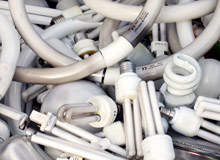
The EU-policed WEEE (waste electrical and electronic equipment) regulation forces manufacturers to become more responsible about components used in electronics to ensure they are deemed safe for the environment at the time of disposal. This has an affect not only for manufacturers working in the EU, but also defence manufacturers anywhere that aim to have a global presence and deal with EU nations.
A few years ago the EU was prompted by the volume and toxic content of electronic and electrical equipment finding its way into landfill to act with regulations and enforcement schemes for the disposal of electronic waste. One such scheme aims to prevent hazardous substances being used in the first place (RoHS or restriction of certain hazardous substances), another is the requirement for responsible disposal, known as the WEEE regulation, which became law two years ago.
By and large, producers have taken these legal obligations seriously and many manufacturers positively advertise their compliance. But behind the scenes there are still some design and manufacturing issues.
At the disposal end, a subtle but significant aspect of the WEEE regulation is the shift of responsibility from the business end-user to the supplier when the product becomes waste: producers pay for the treatment, collection and recycling in most cases (including disposal of batteries) under a separate EU directive. Last month we covered in depth how these schemes work and what they could mean to business. This month we look at how companies can make sure they are compliant, not only for compliance sake, but to ensure that they can trade goods in nations, and with companies, that take the hard line on electronic waste.
Conventional assertions and responses usually imply RoHS compliance is out of scope and a bit of an irritant for military electronic systems and subsystems, however. If pressed, antagonists fall back on security considerations that prevent or conspire against independent RoHS audit.
To remain in step with global electronic manufacturers and to support company standards such as ISO 14001, it is worth defence manufacturers instituting a self-policing mechanism comparable with the BSI RoHS trusted Kitemark scheme.
How well do you really know your competitors?
Access the most comprehensive Company Profiles on the market, powered by GlobalData. Save hours of research. Gain competitive edge.

Thank you!
Your download email will arrive shortly
Not ready to buy yet? Download a free sample
We are confident about the unique quality of our Company Profiles. However, we want you to make the most beneficial decision for your business, so we offer a free sample that you can download by submitting the below form
By GlobalDataTrusted Kitemarking – RoHS
Where it is not possible for military or security reasons to subscribe to the formal Kitemark, internal processes can offer reassurance. They indicate appropriate measures have been taken to ensure product compliance and due diligence over the chain of component supply.
Board and component analysis can be part of an environmental management plan that usually accompanies a delivered system to the customer’s integrated project team. For example, boards can be tested for material compliance. This can be carried out by techniques such as XRF or X-ray fluorescence and provides a guide to where RoHS compliance issues may lie.
Further examination of critical areas can lead to eventual replacement of items or revised manufacturing techniques. The process of drawing up a table that highlights RoHS faults together with a route map towards mitigating their effects offers a trusted management process for upgraded models and for eventual compliance.
WEEE
Companies that put electrical equipment on the market in Europe must register under the producer compliance scheme with the Environment Agency. System designers will then indicate the items that must be marked with a crossed wheelie bin for recovery and/or recycling.
If required, WEEE can relieve a military quartermaster of local disposal through the obligation of the producer to take back unwanted items. In practice this can be neatly tied in with through-life management maintenance, repair and support as determined with the customer’s integrated project team. To the producer, it offers the opportunity to recover high-value items and replenish legacy parts before transporting to a recycling centre where an impressive 98% material reclamation figure is now achievable.
Companies that design and manufacture with WEEE in mind enjoy benefits in the long run. The time alone that could be required to rework and retest equipment and the associated costs should be enough to make companies interested in compliance, not to mention the positive response that comes from having a guaranteed level of social responsibility.







